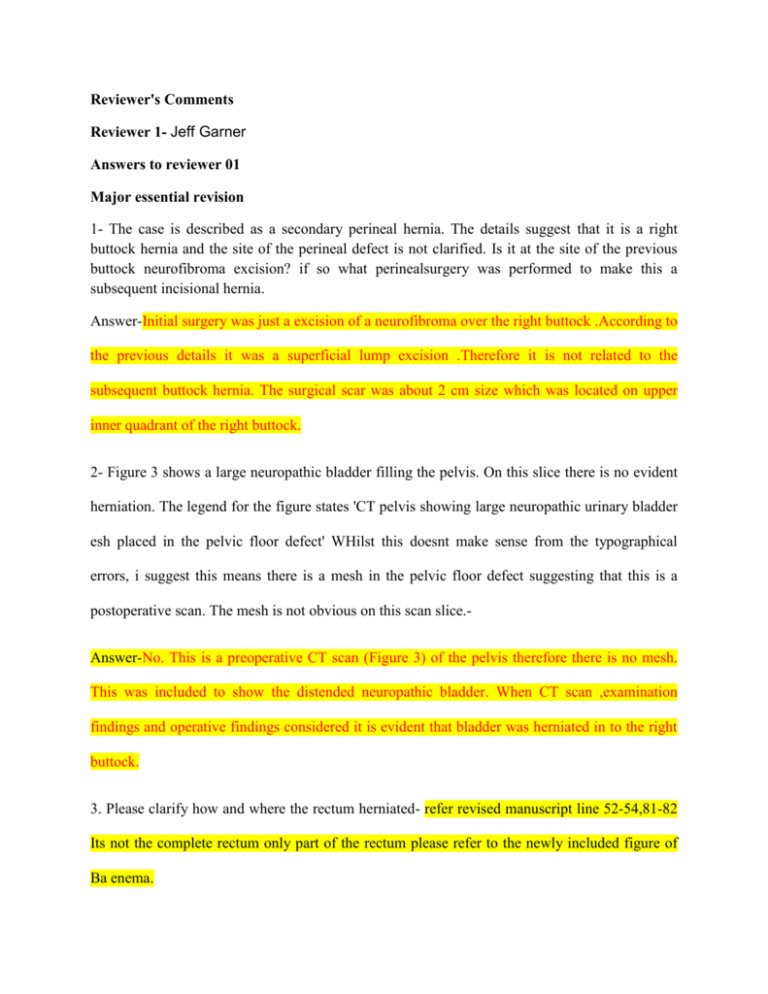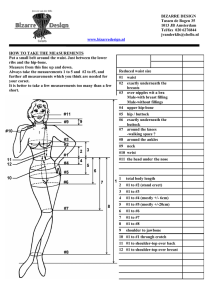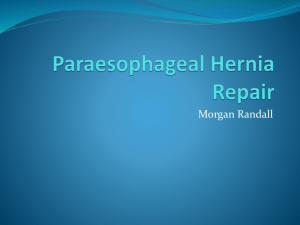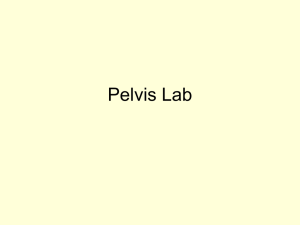Perineal Hernia Case Report: Reviewer Comments & Author Answers
advertisement

Reviewer's Comments Reviewer 1- Jeff Garner Answers to reviewer 01 Major essential revision 1- The case is described as a secondary perineal hernia. The details suggest that it is a right buttock hernia and the site of the perineal defect is not clarified. Is it at the site of the previous buttock neurofibroma excision? if so what perinealsurgery was performed to make this a subsequent incisional hernia. Answer-Initial surgery was just a excision of a neurofibroma over the right buttock .According to the previous details it was a superficial lump excision .Therefore it is not related to the subsequent buttock hernia. The surgical scar was about 2 cm size which was located on upper inner quadrant of the right buttock. 2- Figure 3 shows a large neuropathic bladder filling the pelvis. On this slice there is no evident herniation. The legend for the figure states 'CT pelvis showing large neuropathic urinary bladder esh placed in the pelvic floor defect' WHilst this doesnt make sense from the typographical errors, i suggest this means there is a mesh in the pelvic floor defect suggesting that this is a postoperative scan. The mesh is not obvious on this scan slice.Answer-No. This is a preoperative CT scan (Figure 3) of the pelvis therefore there is no mesh. This was included to show the distended neuropathic bladder. When CT scan ,examination findings and operative findings considered it is evident that bladder was herniated in to the right buttock. 3. Please clarify how and where the rectum herniated- refer revised manuscript line 52-54,81-82 Its not the complete rectum only part of the rectum please refer to the newly included figure of Ba enema. 4. Why did she take 6 weeks to leave hospital? Were there complications?Her post-operative period was complicated with mild respiratory tract infection during 4th week post operatively which was responded conservative management with intra venous antibiotics and chest physiotherapy.Also there was a pericatheter leakage of urine which also settled spontaneously during 2nd post-operative week. 5. My major critiscism of this report is that it doesnt fit togther as an educational piece. The patient has no urinary symptoms at all and so the neurofibromatous infiltration of the bladder is largely irrelevant; the discussion however concentrates exclsuively on NF. No discussion of perineal hernia is made at all. The authors describe an almost unique set of circumstances but do not give details of many relevant factors such as the previous excision that caused the perineal weakness for later herniation, the route of the hernia out of the pelvis into the buttock etc Answer-Although patient didn’t complain about urinary symptoms the filled urinary bladder cauding compression of the rectum would contributed to her obstructive defecation symptoms.Also we would like to mention that organ infiltration by a neurofibroma is a rare thing although this was a incidential finding here. the previous excision that caused the perineal weakness for later herniation, the route of the hernia out of the pelvis into the buttock-these were addressed in previous sections 6. The authors assertion that bladder neurofibromatosis should be considered in cases of obstructed defaecation without urinary symptoms is unsupported by this single case. 7. Figures 2 and 5 do not contribute to the case report. Figure 3 appears to be postoperative and figure 6 was not provided in my review manuscriptAnswerFigure 2 and 5 were included initially as we thought it might add value to the manuscript.If it really necessary to remove those we would consider to do so. Figure 3 is a pre-operative .We would like to mention that we didn’t subjected the patient to CT abdomen and pelvis after surgery. Figure 06-Repaired bladder with suprapubic catheter and mesh placed in the pelvic floor defect 8. For this to be a useful educational report i would like to see more details of the perineal hernia (aetiology, route) and a discussion of the management of perineal hernia. The neurofibromatosis is, to my mind, very much an incidental finding-refer revised article line 52-54 and 78-84 Discretionary revisions 1- A barium enema image showing the herniated rectum would be useful-included Answers to reviewer 02 Reviewer 2 - Prakash Kurumboor This case report is worth publishing, but has many major corrections required: 1. There are many sentences in the manuscript which are unnecessary/not relevant to the condition reported. These are the examples:“This rare condition could be a diagnostic and a management challenge to surgeons as many surgeons may not face a similar condition during their surgical carrier”: Mention this is an extremely rare condition with …… cases reported so far. Mind spelling of carrier, its career!-corrected see the reference number 1 on revised article-line 16 “She attended menopause at the age of 44 years”: no relevance to the condition Described “She was unmarried and had not undergone any major gynecological procedures”. : no relevance to the marriage, though multiparity and gynecological procedures worth mention. ”right knee joint and over R/buttock 7 years back”: Omit short forms like R/buttock and mention right buttock instead. The same to be done through out the manuscript.-Corrected 2. There is mention about Barium enema done the photograph of which would be quite relevant for better understanding of the disease.-included 3. There is no description of the exact site of hernia and the repair done, the description is about bladder instead.-corrected.Refer revised article line 52-54 4. The perineal hernias are classified as below, please see this article and re-write the technique used.They usually protrude through the pelvic diaphragm, and an anterior or posterior form can be distinguished based on their position relative to the transverse perineii muscle.( Salameh JR. Primary and unusual abdominal wall hernias. Surg Clin N – Please see the revised article line 78-84 with the new references No 14,15 Figure xx-Showing herniated rectum








